Slavery, Space, and Social Control on Plantations
Q1 Arts and Humanities
Journal of African Diaspora Archaeology and Heritage
Pub Date : 2022-01-02
DOI:10.1080/21619441.2022.2079251
引用次数: 0
Abstract
Since the turn of the twenty-first century, the public history presented at American and Caribbean plantations has been the subject of growing scholarly critique (e.g., Carter 2016; Eichstedt and Small 2002; Modlin and Arnold 2008; Walcott-Wilson 2020). Geographers, linguists, historians, anthropologists, and archaeologists have decried the continuing tendency of many plantation museum tours to sanitize, minimize, or even erase slavery. The daily labor, suffering, and terror of past enslaved Black residents is masked when tours focus on the beauty of formal gardens, stately houses, and orderly landscapes. Indeed, the racial violence that was latent in such estates’ picturesque designs can easily remain obscured in the present, allowing plantations to present as beautiful spaces untethered to their painful histories. Certainly, the beauty and “orderliness” of plantations in the U.S. and the Caribbean was created intentionally by their owners. Architectural historian Dell Upton (1984) has argued that plantations were far from singular unified spaces; rather, they encompassed both white and Black landscapes in the same space, created for and experienced by different audiences. For one, plantation landscapes were tools of communication by which white owners might signal social standing (aspirational or real) to white neighbors. At the same time, as contributions to this special issue demonstrate, plantations were purposefully spatially organized to better enable the control and domination of enslaved Black residents. For decades, archaeologists have analyzed how plantation spatial organization fostered the social control of enslaved people. In previous studies, the idea of the panopticon as popularized by Michel Foucault (1977) has been particularly emphasized (e.g., Bates 2015; Delle 2011; Singleton 2001). A panopticon is a place from which total surveillance of the surrounding area is possible; crucially, the panopticon at the same time obscures the presence or absence of an observer from those who may be observed. Foucault explored this concept most extensively in his thinking about prisons and how prisoners’ uncertainty about whether they were being observed at any one time from, say, a guard tower, might lead them to monitor their behavior as if they were being watched even when, in actuality, the tower might be empty. Archaeologists working at plantations have applied the idea of a panopticon to understand how an owner’s house or an overseer’s residence could act as an actual vantage point to surveil enslaved people while also suggesting the possibility of surveillance at all times, thus causing enslaved people to monitor themselves and participate in their own subjugation even when in reality they were unwatched by overseers or enslavers. This collection builds on the insights of these previous studies with methodological and theoretical innovations that move us toward a more complete understanding of social control as spatially expressed and enacted on plantations. The latent violence of plantation landscapes is explored in microcosm at Maryland’s L’Hermitage Plantation by Megan Bailey. The plantation’s owners, the Vincendières, arrived in Maryland in the 1790s from Saint Domingue (present-day Haiti). The Vincendières’ particular cruelty and vindictiveness is recorded historically through multiple legal cases brought against them by their enslaved workers for mistreatment as well as奴隶制、空间和种植园的社会控制
自21世纪之交以来,美国和加勒比种植园的公共历史一直是越来越多的学术批评的主题(例如,Carter 2016;Eichstedt and Small 2002;Modlin and Arnold 2008;Walcott-Wilson 2020)。地理学家、语言学家、历史学家、人类学家和考古学家都谴责了许多种植园博物馆之旅持续存在的淡化、最小化甚至抹去奴隶制的倾向。过去被奴役的黑人居民的日常劳动、痛苦和恐怖被掩盖了,当游客把注意力集中在正式的花园、庄严的房屋和有序的景观之美时。事实上,这些庄园风景如画的设计中潜藏的种族暴力在现在很容易被掩盖,这使得种植园成为一个不受痛苦历史束缚的美丽空间。当然,美国和加勒比地区种植园的美丽和“有序”是它们的主人故意创造的。建筑历史学家Dell Upton(1984)认为,种植园远非单一的统一空间;相反,它们在同一个空间中包含了白色和黑色的景观,为不同的观众创造和体验。首先,种植园景观是一种沟通工具,白人所有者可以通过它向白人邻居表明社会地位(理想的或真实的)。与此同时,正如本期特刊的投稿所表明的那样,种植园被有目的地在空间上组织起来,以便更好地控制和统治被奴役的黑人居民。几十年来,考古学家一直在分析种植园空间组织如何促进对奴隶的社会控制。在之前的研究中,米歇尔·福柯(1977)推广的圆形监狱的概念得到了特别的强调(例如,Bates 2015;Delle 2011;单2001)。panopticon是一个可以对周围地区进行全面监视的地方;至关重要的是,圆形监狱同时模糊了观察者的存在或不存在于可能被观察的人之中。福柯在他对监狱的思考中最广泛地探讨了这个概念,以及囚犯如何不确定自己是否在任何时候被监视,比如在一个警卫塔上,这可能会导致他们监控自己的行为,就好像他们被监视一样,即使实际上,塔楼可能是空的。在种植园工作的考古学家运用了圆形监狱的概念来理解主人的房子或监工的住所如何成为监视奴隶的实际有利位置,同时也暗示了随时监视的可能性,从而使被奴役的人监视自己并参与自己的征服,即使在现实中他们没有被监工或奴隶监视。本文集建立在前人研究的基础上,通过方法论和理论创新,使我们更全面地理解社会控制在种植园的空间表达和实施。在马里兰州的L 'Hermitage种植园,Megan Bailey在微观世界中探索了种植园景观的潜在暴力。种植园的主人vincendi家族于18世纪90年代从圣多明各(今海地)来到马里兰州。vincendi家族的残忍和报复心在历史上被记录下来,他们的奴隶工人对他们提起了多起法律诉讼,指控他们虐待他们
本文章由计算机程序翻译,如有差异,请以英文原文为准。
求助全文
约1分钟内获得全文
求助全文
来源期刊

Journal of African Diaspora Archaeology and Heritage
Arts and Humanities-History
CiteScore
0.80
自引率
0.00%
发文量
9
期刊介绍:
Journal of African Diaspora Archaeology and Heritage provides a focal point for peer-reviewed publications in interdisciplinary studies in archaeology, history, material culture, and heritage dynamics concerning African descendant populations and cultures across the globe. The Journal invites articles on broad topics, including the historical processes of culture, economics, gender, power, and racialization operating within and upon African descendant communities. We seek to engage scholarly, professional, and community perspectives on the social dynamics and historical legacies of African descendant cultures and communities worldwide. The Journal publishes research articles and essays that review developments in these interdisciplinary fields.
 求助内容:
求助内容: 应助结果提醒方式:
应助结果提醒方式:


